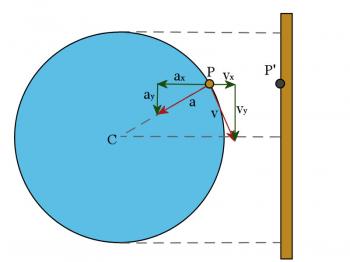Simple Harmonic Motion
Reference > Science > Physics > Study Guide > Unit 6: Rotational and Simple Harmonic MotionFrequently we encounter a type of motion, called harmonic motion, where an object moves back and forth along a line. One kind of harmonic motion, called simple harmonic motion (SHM), is best thought of as a special case of rotational motion, so will be introduced here.
Consider a flat disk resting on a turntable with a small object attached to the disk so that it protrudes above the surface of the disk. Now place a screen near the disk and shine a light on the disk so that a shadow of the object is thrown on the screen, and start the disk in rotation. You will see the shadow move back and forth on the screen. If you study the motion for a moment, you will realize that the object stops at one end, starts moving toward the other end of its motion, reaches its maximum speed at the midpoint of its motion, begins to slow down, and stops at the other end. It then moves in the same manner in the other direction.

Figure 6.4.1
To analyze the motion you need a good sketch of the circular motion which produces it. Study Figure 6.4.1. At the left is a diagram of the motion of the object in a circular path and at the right is a diagram of the motion of the shadow. As with any periodic motion, we define the period, T, as the time for one complete cycle and the frequency, f, as the number of cycles completed per second. It should be clear to you that the periods and frequencies of the two motions are the same since it takes exactly the same time for the disk to complete one complete revolution as it takes for the shadow to move from top to bottom and back again. We also will define the amplitude of the SHM as the distance from either end to the midpoint of the motion. This is the same as the radius of the associated circular motion.
Consider the circular motion first. The speed of the object will be given byFrom this we see that we will get simple harmonic motion whenever the force is proportional to the negative of the displacement. The negative sign simply means that the force will be in the opposite direction from the displacement. This also means that the force will always be directed toward the equilibrium point. A weight bouncing up and down on the end of a spring closely approximates this condition and there are many other examples of this motion in Physics.
As with the other material, you will understand this better after you work through the solved problems.
Sample Problem #1
A weight on the end of a spring is displaced 10 cm from its equilibrium position and released. It then oscillates up and down, making 10 vibrations each minute. Calculate:
- the maximum speed of the object
- the maximum acceleration
- the speed and acceleration of the weight when it is 5 cm above the equilibrium point and is moving down.
Sample Solution #1
In this kind of problem, you need to keep in mind two related motions: the motion of the weight, which is simple harmonic motion, and the circular motion of an object which will duplicate the SHM when viewed on edge. First draw two diagrams. One of the object in SHM and the other of the circular motion which corresponds to it. Refer to Figure 6.4.1 above. Then list all the known variables, keeping in mind that some variables have the same value for both motions.
v =
v = 200p
a =
a = 4000p2
v = 173.2p
a = 200p2
All problems in SHM can be handled this way. Just be sure to draw a careful and accurate diagram. Draw the diagram large enough so that all the vectors, the appropriate angles, and the components can be clearly shown.
Sample Problem #2
A simple pendulum (a point mass on the end of a rigid, massless rod) moving through small angles executes a motion that is very nearly SHM. The pendulum's period given by the following equation:
For this formula, l is the length of the pendulum and ag is the acceleration of gravity.
A simple pendulum has a period of 2.40 sec at a place where ag= 9.8Sample Solution #2
The period is 2.40 s, when ag = 9.8
(2.40)2 = 4p2(
Therefore, l = 1.43 m.
We now can use this length, along with the new period, to determine ag at the other location on the earth's surface:
(2.41)2 = 4p2(
Questions
 Rotational Dynamics
Rotational Dynamics Unit Index
Unit Index

